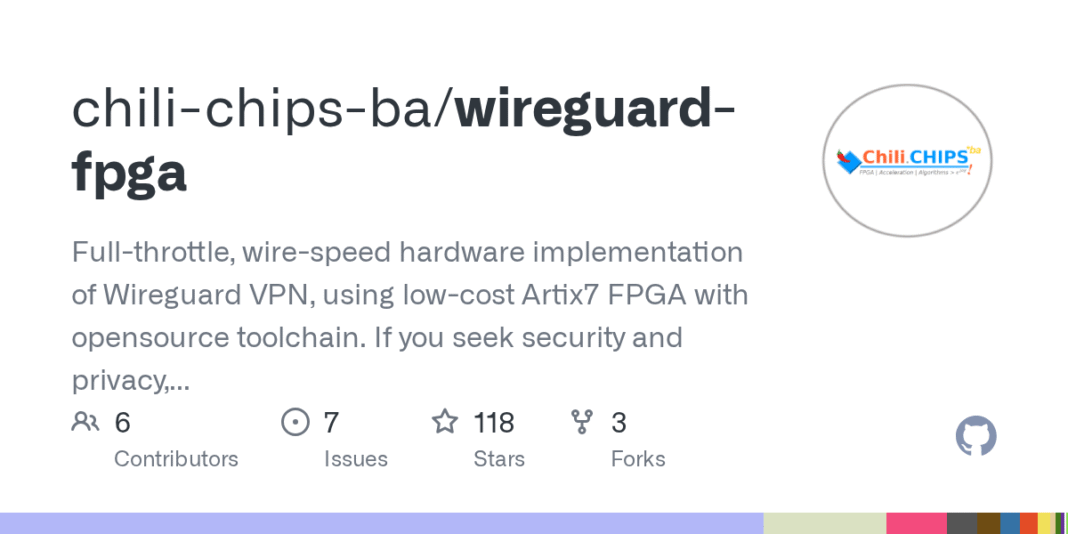Virtual Private Networks (VPNs) are the central and indispensable component of Internet security. They comprise a set of technologies that connect geographically dispersed, heterogeneous networks through encrypted tunnels, creating the impression of a homogenous private network on the public shared physical medium.


With traditional solutions (such as OpenVPN / IPSec) starting to run out of steam, Wireguard is increasingly coming to the forefront as a modern, secure data tunneling and encryption method, one that’s also easier to manage than the incumbents. Both software and hardware implementations of Wireguard already exist. However, the software performance is far below the speed of wire. Existing hardware approaches are both prohibitively expensive and based on proprietary, closed-source IP blocks and tools.
- The intent of this project is to bridge these gaps with an FPGA open-source implementation of Wireguard, written in SystemVerilog HDL.
We have contributed to the Blackwire project, which is a 100Gbps hardware implementation of Wireguard switch based on AMD/Xilinx-proprietary AlveoU50 PC-accelerator card (SmartNIC form-factor), and implementable only with proprietary Vivado toolchain.
While working on the Blackwire, we have touched multiple sections, and focused on the novel algorithm for Balanced Binary Tree Search of IP tables. However, the Blackwire hardware platform is expensive and priced out of reach of most educational institutions. Its gateware is written in SpinalHDL, a nice and powerfull but a niche HDL, which has not taken roots in the industry. While Blackwire is now released to open-source, that decision came from their financial hardship — It was originaly meant for sale. Moreover, the company behind it is subject to disputes and obligations that bring into question the legality of ownership over the codebase they “donated” to the open source community.
To make the hardware Wireguard truly accessible in the genuine spirit of open-source movement, this project implements it:
- for an inexpensive hardware platform with four 1000Base-T ports
- in a self-sufficient way, i.e. w/o requiring PC host
- using a commodity Artix7 FPGA
- which is supported by open-source tools
- and with all gateware written in the ubiquitous Verilog / System Verilog
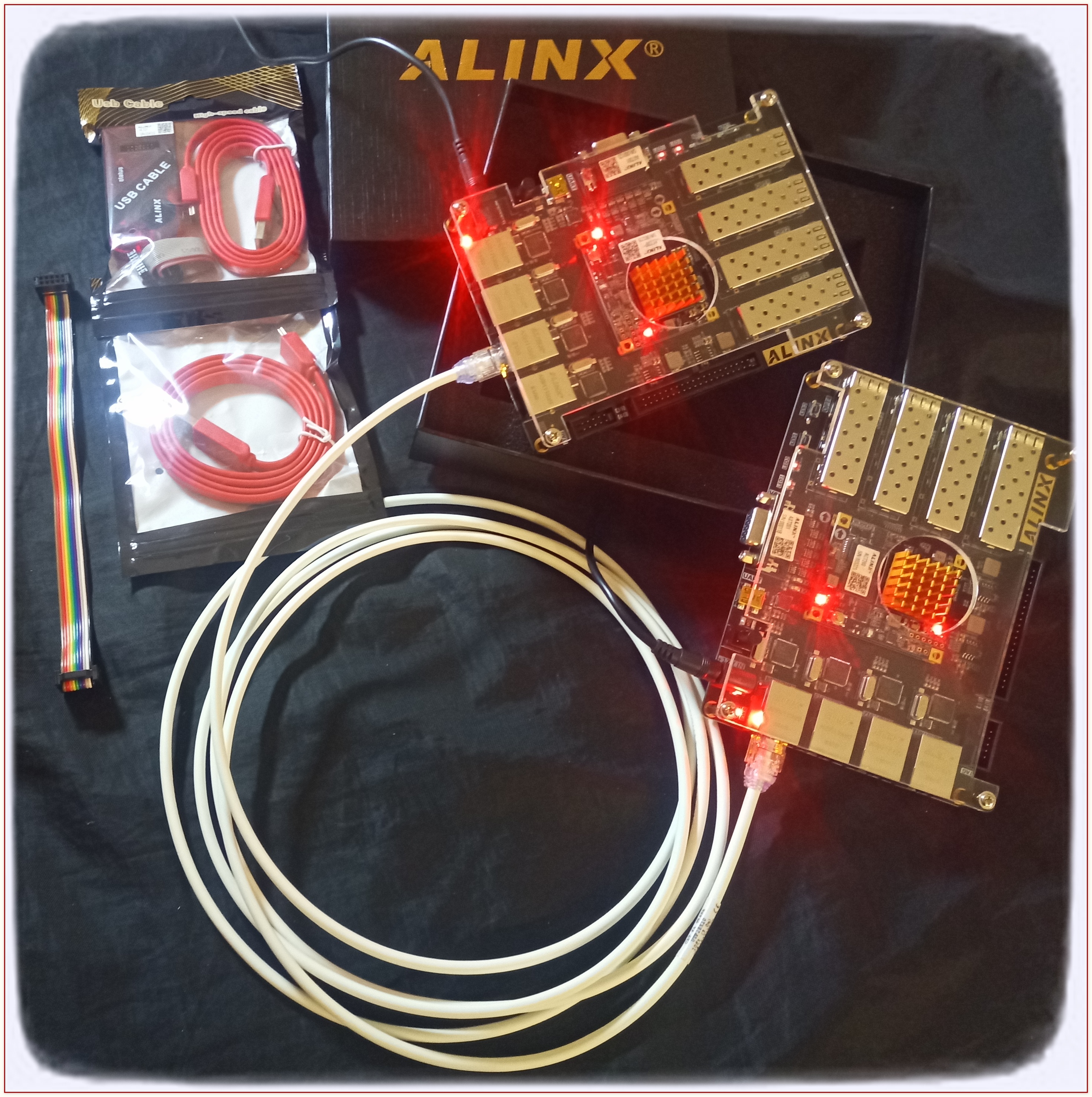
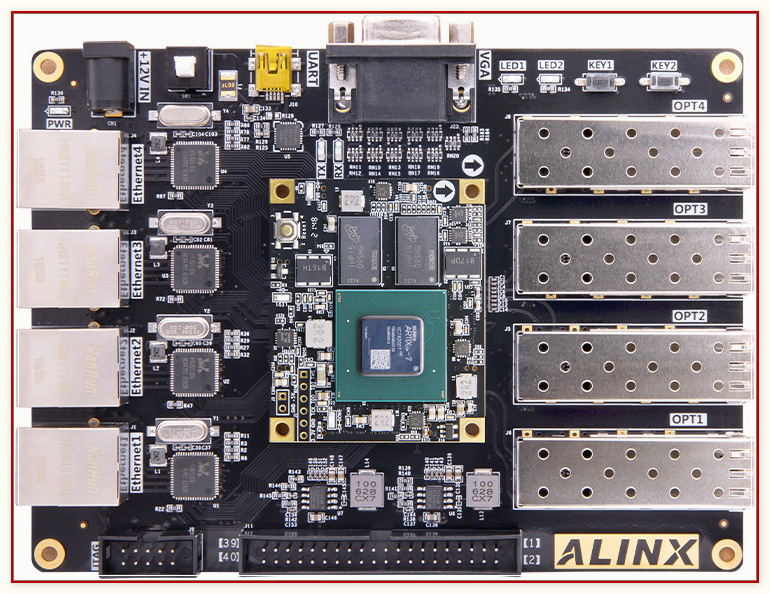
[Ref1] Wireguard implementations in software:
[Ref2] 100Gbps Blackwire Wireguard
[Ref3] Corundum, open-source FPGA-NIC platform
[Ref4] ChaCha20-Poly1305 open-source Crypto RTL
[Ref5] Cookie Cutter SOC
[Ref6] RISC-V ISS
[Ref7] 10Gbps Ethernet Switch
[Ref8] OpenXC7 open-source tools for Xilinx Series7
[Ref9] Alex’s Ethernet Stack
[Ref10] Amina’s ADASEC-SDN
The Phase1 (This!) is primarily Proof of Concept, i.e. not full-featured, and definitely not a deployable product. It is envisoned as a mere on-ramp, a springboard for future build-up and optimizations.
The Phase2 continuation project is therefore also in the plans, to maximize efficiency and overall useability, such as by increasing the number of channels, facilitating management with GUI apps, or something else as identified by the community feedback.
-
HW/SW partitioning, interface, interactions and workload distribution
- While, contrary to Blackwire, we don’t rely on an external PC connected via PCIE, we will still have an on-chip RISC-V CPU with intricate hardware interface and significant Embedded Software component that controls the backbone of wire-speed datapath
-
HW/SW co-development, integration and debugging
- Standard simulation is impractical for the project of this size and complexity. We therefore intend to put to test and good use the very promissing new VProc ISS [Ref6]
- It’s also impractical and expensive to provide full test systems with real traffic generators and checkers to all developers. We therefore plan to rent some space for a central lab that will host two test systems, then provide remote access to all developers
-
Real-life, at-speed testing
-
Extent of open-source tools support for SystemVerilog and all needed FPGA primitives and IP functions
-
QOR of the (still maturing) open-source tools
- Blackwire used commercial, AMD/Xilinx-proprietary Vivado toolchain, as well as high-end Alveo U50 FPGA silicon. Even then, they ran into multiple timing closure, utilization and routing congestion challenges.
-
Financial resources
- Given that this is a complex, multi-disciplinary dev effort, the available funding may not be sufficient to bring it to completion. Blackwire, despite a larger allocated budget, ended up with funding crisis and abrupt cessation of dev activities.
This project is WIP at the moment. The checkmarks below indicate our status. Until all checkmarks are in place, anything you get from here is w/o guaranty — Use at own risk, as you see fit, and don’t blame us if it is not working 🌤️
Board bring up. In-depth review of Wireguard ecosystem and prior art. Design Blueprint
While the board we’re using is low cost, it is also not particularly known in the open-source community. We certainly don’t have prior experience with it. In this opening take we will build a solid foundation for efficient project execution. Good preparation is crucial for a smooth run. We thus seek to first understand and document what we will be designing: SOC Architecture, Datapath Microarchitecture, Hardware/Software Partitioning, DV and Validation Strategy.
Getting a good feel for our Fmax is also a goal of this take. Artix-7 does not support High-Performance (HP) I/O. Consequently, we cannot push its I/O beyond 600MHz, nor its core logic beyond 100 MHz.
Implementation of a basic, statically pre-configured Wireguard link
It it in this take that we start creating hardware Datapath and hardening Wireguard encryption protocols, all using Vivado and Xilinx primitives.
Development and integration of embedded management software (Control Plane)
This work package is about hardware/software codesign and integration. The firmware will run on a soft RISC V processor, inside the FPGA. Our vanilla SOC is at this point starting to be customized to Wireguard needs. This work can to some extent go on in parallel with hardware activities of Take2.
VPN Tunnel: Session initialization, maintenance, and secure closure
This is about managing the bring-up, maintenance and tear-down of VPN tunnels between two devices.
Testing, Profiling and Porting to OpenXC7
Take6 (time-permitting Bonus)
Flow control module for efficient and stable VPN tunnel data management
The objective of this optional deliverable is to ensure stable and efficient links, thus taking this project one step closer to a deployable product.
Since the WireGuard node essentially functions as an IP router with WireGuard protocol support, we have decided to design the system according to a two-layer architecture: a control plane responsible for managing IP routing processes and executing the WireGuard protocol (managing remote peers, sessions, and keys), and a data plane that will perform IP routing and cryptography processes at wire speed. The control plane will be implemented as software running on a soft CPU, while the data plane will be fully implemented in RTL on an FPGA.
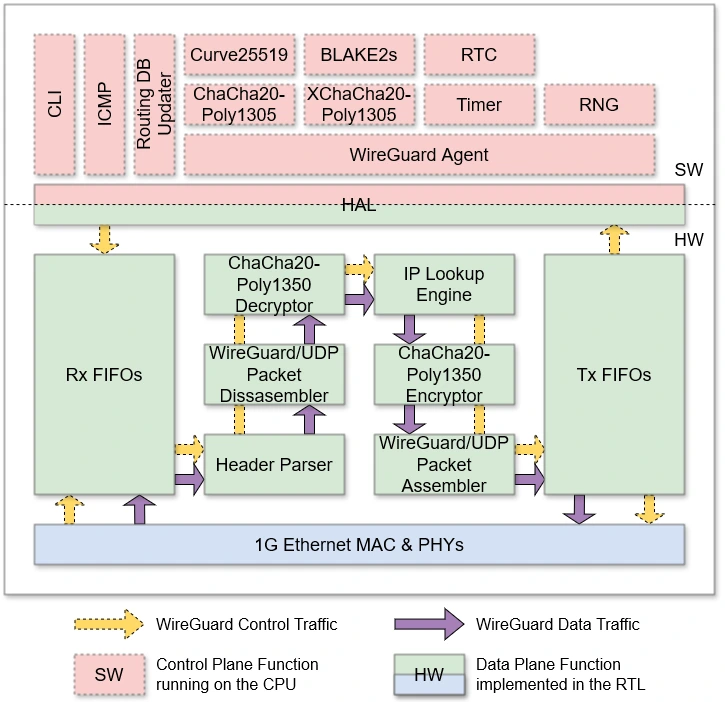
In the HW/SW partitioning diagram, we can observe two types of network traffic: control traffic, which originates from the control plane and goes toward the external network (and vice versa), and data traffic, which arrives from the external network and, after processing in the data plane, returns to the external network. Specifically, control traffic represents WireGuard protocol handshake messages, while data traffic consists of end-user traffic, either encrypted or in plaintext, depending on the perspective.
Hardware Architecture and Theory of Operation
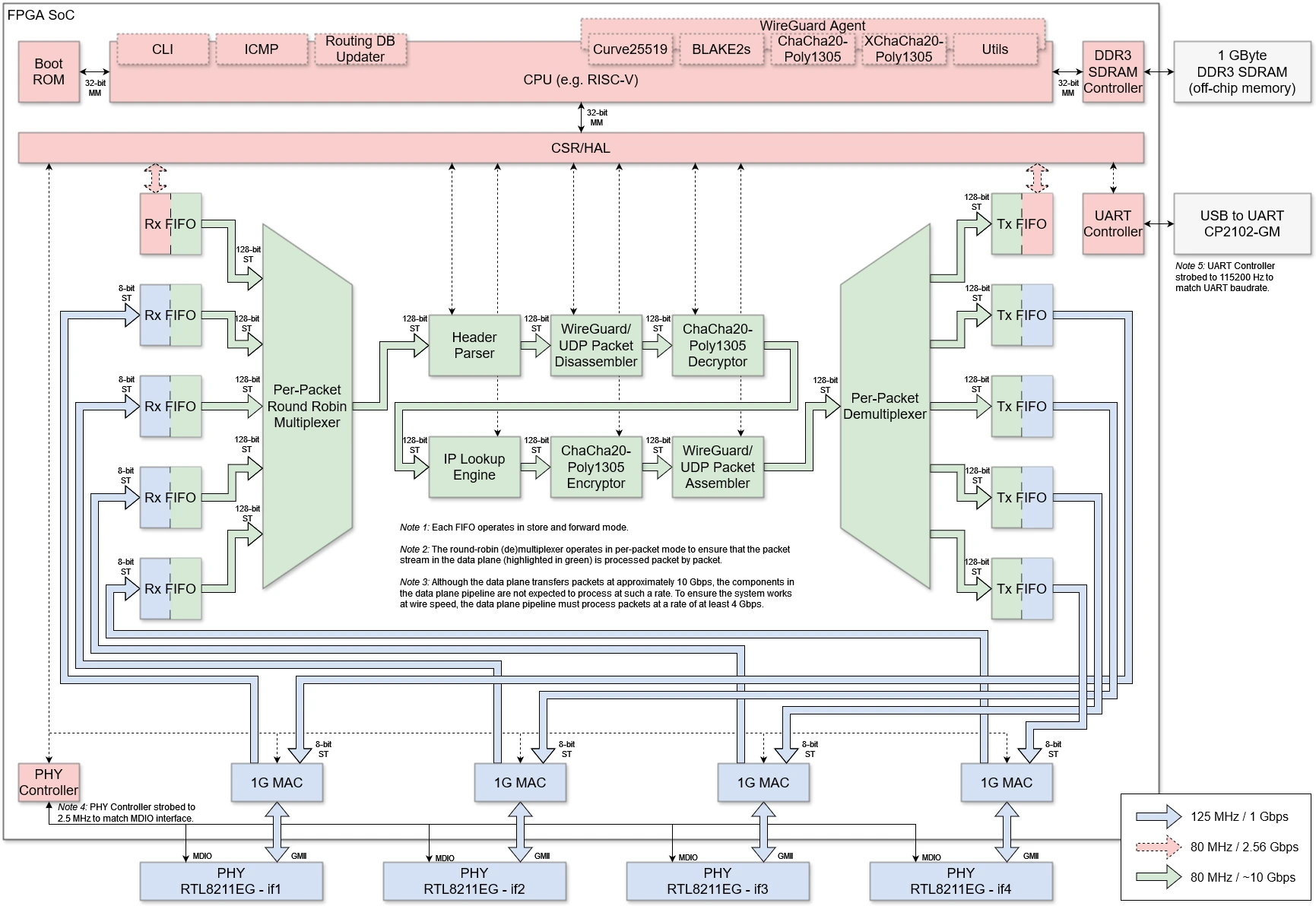
The hardware architecture essentially follows the HW/SW partitioning and consists of two domains: a soft CPU for the control plane and RTL for the data plane.
The soft CPU is equipped with a Boot ROM and a DDR3 SDRAM controller for interfacing with off-chip memory. External memory is exclusively used for control plane processes and does not store packets. The connection between the control and data planes is established through a CSR-based HAL.
The data plane consists of several IP cores, including data plane engine (DPE) and supporting components, which are listed and explained in the direction of network traffic propagation:
- PHY Controller – initial configuration of Realtek PHYs and monitoring link activity (link up/down events)
- 1G MAC – execution of the 1G Ethernet protocol (framing, flow control, FCS, etc.)
- Rx FIFOs – clock domain crossing, bus width conversion, and store & forward packet handling
- Per-Packet Round Robin Multiplexer – servicing Rx FIFOs on a per-packet basis using a round-robin algorithm
- Header Parser – extraction of WireGuard-related information from packet headers (IP addresses, UDP ports, WireGuard message type, peer ID, etc.)
- Wireguard/UDP Packet Disassembler – decapsulation of the payload from the Wireguard data packet for decryption of tunneled traffic
- ChaCha20-Poly1305 Decryptor – decryption and authentication of tunneled traffic
- IP Lookup Engine – routing/forwarding table lookup, mapping packets to the appropriate WireGuard peer, and making packet accept/reject decisions
- ChaCha20-Poly1305 Encryptor – encryption and authentication of traffic to be tunneled
- Wireguard/UDP Packet Assembler – encapsulation of the encrypted packet into a WireGuard data packet for tunneling to the remote peer
- Per-Packet Demultiplexer – forwarding packets to Tx FIFOs based on packet type and destination
- Tx FIFOs – clock domain crossing, bus width conversion, and store & forward packet handling
ChaCha20-Poly1305 Encryptor/Decryptor are using RFC7539’s AEAD (Authenticated Encryption Authenticated Data) construction based on ChaCha20 for symmetric encryption and Poly1305 for authentication.
The details of hardware architecture can be found in the README.md in the 1.hw/ directory.
Software Architecture and Theory of Operation
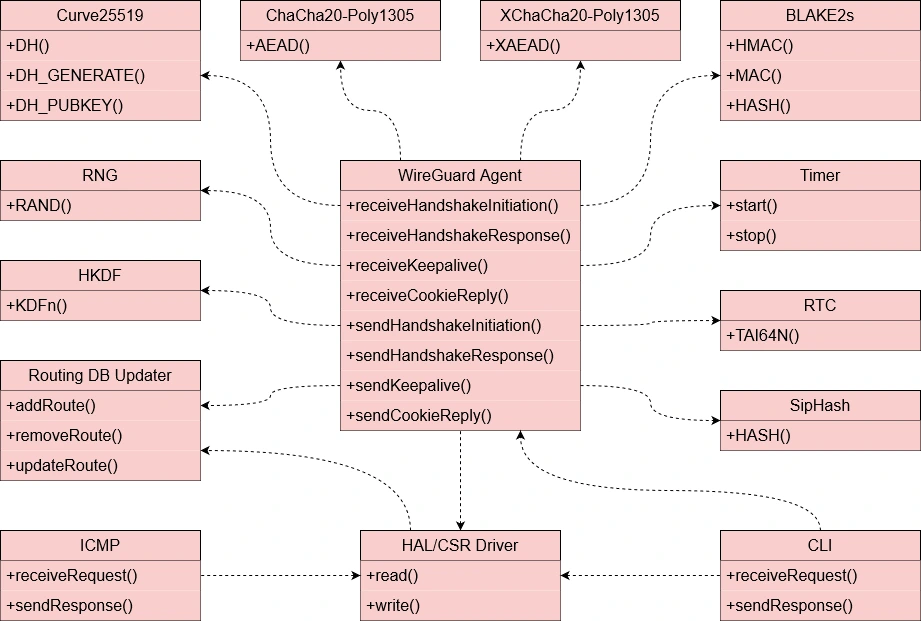
The conceptual class diagram provides an overview of the components in the software part of the system without delving into implementation details. The focus is on the WireGuard Agent, which implements the protocol’s handshake procedures, along with the following supplementary components:
- Curve25519 – an ECDH algorithm implementation for establishing a shared secret using a public-private key pair between two remote parties connected via an insecure channel, such as the Internet
- ChaCha20-Poly1305 – an AEAD algorithm implementation for encryption and authentication of static keys and nonce values to prevent replay attacks
- XChaCha20-Poly1305 – a XAEAD algorithm implementation for encrypting and authenticating nonce values in Cookie Replay messages to mitigate potential DoS attacks
- BLAKE2s – an implementation of the BLAKE2s hash function for MAC authentication and keyed hashing, per RFC7693
- RNG – a random number generator used to initialize the DH key generator and generate peer identifiers
- Timer – timers for rekey, retry, and keepalive procedures
- HKDF – an implementation of the algorithm for expanding the ECDH result
- RTC – a real-time clock used to generate the TAI64N timestamp
- SipHash – a simple non-cryptographic function used for implementing a hashtable for fast lookup of decrypted static public keys of remote peers
- Routing DB Updater – a subsystem for maintaining the cryptokey routing table content and deploying it to the data plane via the HAL/CSR interface
- ICMP – implementing basic ICMP protocol functions (echo request/reply, TTL exceeded, etc.)
- CLI – a USB/UART-based command-line interface for configuring the WireGuard node (setting the local IP address, remote peer IP addresses, network addresses, keys, etc.)
- HAL/CSR Driver – a CSR-based abstraction for data plane components with an interface for reading/writing the corresponding registers
The details of software architecture can be found in the README.md in the 2.sw/ directory.
HW/SW Working Together as a Coherent System
To illustrate the operation of the system as a whole, we have prepared a step-by-step analysis of packets processing based on the capture of real WireGuard traffic. The experimental topology consists of four nodes:
- 10.10.0.2 – the end-user host at site A
- 10.9.0.1 – WireGuard peer A
- 10.9.0.2 – WireGuard peer B
- 10.10.0.1 – the end-user host at site B

The detailed analysis can be found in the README.md in the 1.hw/ directory.
The Wireguard FPGA test bench aims to have a flexible approach to simulation which allows a common test environment to be used whilst selecting between alternative CPU components, one of which uses the VProc virtual processor co-simulation element. This allows simulations to be fully HDL, with a RISC-V processor RTL implementation such as picoRV32, IBEX or EDUBOS5, or to co-simulate software using the virtual processor, with a significant speed up in simulation times. The test bench has the following features:
The figure below shows an oveview block diagram of the test bench HDL.
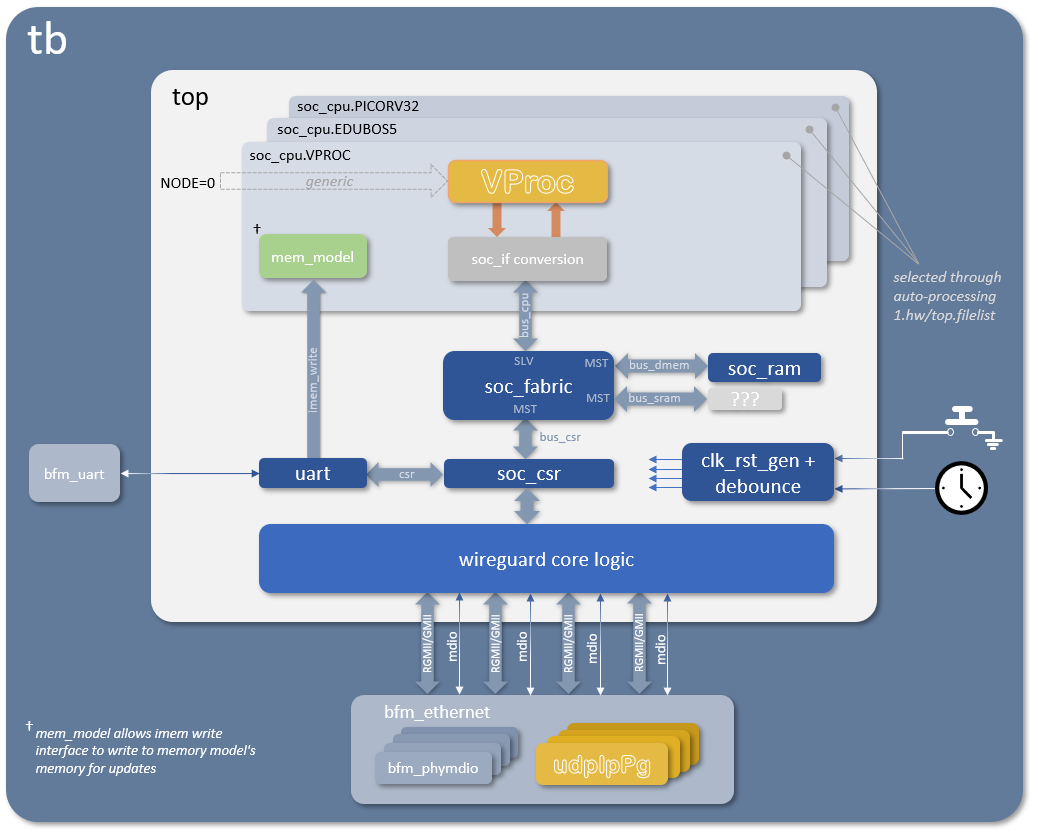
More details on the architecture and usage of the Wireguard test bench can be found in the README.md in the 4.sim directory.
The Wireguard control and status register harware abstraction layer (HAL) software is auto-generated, as is the CSR RTL, using peakrdl. For co-simulation purposes an additional layer is auto-generated from the same SystemRDL specification using systemrdl-compiler that accompanies the peakrdl tools. This produces two header files that define a common API to the application layer for both the RISC-V platform and the VProc based co-simulation verification environment. The details of the HAL generation can be found in the README.md in the 3.build/ directory.
Lab Test and Validation Setup
TODO
Shared Linux Server with tools
WIP
- Verilator v5.024
- VProc v1.12.2
- Mem Model v1.0.0
- rv32 ISS v1.1.4
- udpIpPg v1.0.3
TODO
TODO
CPU Live debug and reload
TODO
TODO
We are grateful to NLnet Foundation for their sponsorship of this development activity.


The wyvernSemi‘s wisdom and contribution made a great deal of difference — Thank you, we are honored to have you on the project.

